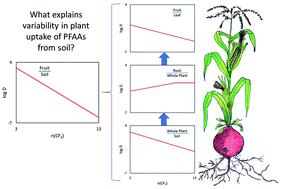当前位置:
X-MOL 学术
›
Environ. Sci.: Processes Impacts
›
论文详情
Our official English website, www.x-mol.net, welcomes your
feedback! (Note: you will need to create a separate account there.)
Uptake of perfluorinated alkyl acids by crops: results from a field study
Environmental Science: Processes & Impacts ( IF 4.3 ) Pub Date : 2021-07-14 , DOI: 10.1039/d1em00166c Sebastian Felizeter 1 , Heinrich Jürling , Matthias Kotthoff , Pim De Voogt , Michael S McLachlan
Environmental Science: Processes & Impacts ( IF 4.3 ) Pub Date : 2021-07-14 , DOI: 10.1039/d1em00166c Sebastian Felizeter 1 , Heinrich Jürling , Matthias Kotthoff , Pim De Voogt , Michael S McLachlan
Affiliation

|
Four crops with different edible plant parts (radish, lettuce, pea and maize) were grown in outdoor lysimeters on soil spiked with 13 perfluorinated alkyl acids (PFAAs) at 4 different levels. PFAA concentrations were measured in soil, soil pore water, and different plant parts at harvest. Edible part/soil concentration factors ranged over seven orders of magnitude and decreased strongly with increasing PFAA chain length, by a factor of 10 for each additional fluorinated carbon (nCF) for pea. Three processes were responsible for most of the variability. The first was sorption to soil; calculating whole plant concentration factors on the basis of concentration in pore water instead of soil reduced the variability from five orders of magnitude to two. Second, the journey of the PFAAs with the transpiration stream to the leaves was hindered by retention in the roots driven by sorption; root retention factors increased by a factor 1.7 for each nCF. Third, transfer of PFAAs from the leaves to the fruit via the phloem flow was also hindered – presumably by sorption; fruit/leaf concentration factors decreased by a factor 2.5 for each nCF. A simple mathematical model based on the above principles described the measured concentrations in roots, leaves, fruits and radish bulbs within a factor 4 in most cases. This indicates that the great diversity in PFAA transfer from soil to crops can be largely described with simple concepts for four markedly different species.
中文翻译:

作物对全氟烷基酸的吸收:实地研究结果
四种具有不同可食用植物部分(萝卜、生菜、豌豆和玉米)的作物在室外渗漏仪中种植,土壤中添加了 4 个不同浓度的 13 种全氟烷基酸 (PFAA)。在收获时测量了土壤、土壤孔隙水和不同植物部位中的 PFA 浓度。可食用部分/土壤浓度因子范围超过 7 个数量级,并且随着 PFAA 链长度的增加而急剧下降,对于豌豆来说,每增加一个氟化碳 ( n CF ),浓度因子就会下降 10 倍。三个过程造成了大部分的变异性。第一个是土壤的吸附;根据孔隙水而不是土壤的浓度计算整个植物的浓度因子,将变异性从五个数量级减少到两个数量级。其次,PFAA 随蒸腾流到达叶子的旅程受到吸附驱动的根部滞留的阻碍;每n CF根保留因子增加 1.7 倍。第三,PFAA通过韧皮部流从叶子转移到果实也受到阻碍——可能是通过吸附作用;对于每个n CF ,果实/叶子浓度因子减少 2.5 倍。基于上述原理的简单数学模型在大多数情况下描述了根、叶、果实和萝卜球茎中测量的浓度,其误差在 4 倍以内。这表明,PFAA 从土壤到作物转移的巨大多样性可以在很大程度上用四个明显不同物种的简单概念来描述。
更新日期:2021-07-14
中文翻译:

作物对全氟烷基酸的吸收:实地研究结果
四种具有不同可食用植物部分(萝卜、生菜、豌豆和玉米)的作物在室外渗漏仪中种植,土壤中添加了 4 个不同浓度的 13 种全氟烷基酸 (PFAA)。在收获时测量了土壤、土壤孔隙水和不同植物部位中的 PFA 浓度。可食用部分/土壤浓度因子范围超过 7 个数量级,并且随着 PFAA 链长度的增加而急剧下降,对于豌豆来说,每增加一个氟化碳 ( n CF ),浓度因子就会下降 10 倍。三个过程造成了大部分的变异性。第一个是土壤的吸附;根据孔隙水而不是土壤的浓度计算整个植物的浓度因子,将变异性从五个数量级减少到两个数量级。其次,PFAA 随蒸腾流到达叶子的旅程受到吸附驱动的根部滞留的阻碍;每n CF根保留因子增加 1.7 倍。第三,PFAA通过韧皮部流从叶子转移到果实也受到阻碍——可能是通过吸附作用;对于每个n CF ,果实/叶子浓度因子减少 2.5 倍。基于上述原理的简单数学模型在大多数情况下描述了根、叶、果实和萝卜球茎中测量的浓度,其误差在 4 倍以内。这表明,PFAA 从土壤到作物转移的巨大多样性可以在很大程度上用四个明显不同物种的简单概念来描述。









































 京公网安备 11010802027423号
京公网安备 11010802027423号